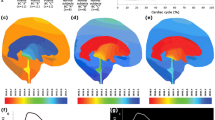Abstract
Hydrocephalus is a clinical condition characterized by abnormalities in the cerebrospinal fluid (CSF) circulation resulting in ventricular dilation. Within limits, the dilation of the ventricles can be reversed by either a shunt placement in the brain or by performing a ventriculostomy surgery, resulting in a relief from the symptoms of hydrocephalus. However, the response of patients to either treatment continues to be poor. Therefore, there is an earnest need to design better therapy protocols for hydrocephalus. An important step in this direction is the development of predictive computational models of the mechanics of hydrocephalic brains. In this paper we present an Immersed Finite Element Method (IFEM) approach to study brain mechanics. IFEM is an emerging computational method that is suitable for analyzing the complex interactions between fluid and deformable structures. We model the brain as a neo-Hookean material that is submerged in the CSF modeled as a Newtonian fluid. We use medical images of a hydrocephalic brain to generate the mesh for the immersed solid. Our preliminary results show that the viscosity of CSF has a significant influence on the deformation of the brain tissue. We believe that our study could play an important role in predicting and ultimately improving the outcome of ventriculostomy.
Access this chapter
Tax calculation will be finalised at checkout
Purchases are for personal use only
Similar content being viewed by others
References
Di Rocco C, Massimi L, Tamburrini G (2006) Shunts vs endoscopic third ventriculostomy in infants: are there different types and/or rates of complications? Child Nerv Syst 22:1573–1589
Kulkarni AV, Drake JM, Kestle JR, Mallucci CL, Sgouros S, Constantini S (2010) Endoscopic third ventriculostomy vs cerebrospinal fluid shunt in the treatment of hydrocephalus in children: a propensity score-adjusted analysis. Neurosurgery 67(3):588–593
Brainweb: Simulated brain database. http://www.bic.mni.mcgill.ca/brainweb
Kwan RKS, Evans AC, Pike GB (1996) Visualization in biomedical computing, vol 1131. Lecture notes in computer Science, chapter an extensible MRI simulator for post-processing evaluation. Springer, New York, pp 135–140
Cocosco CA, Kollokian V, Kwan RKS, Evans AC (1997) Brainweb: Online interface to a 3D MRI simulated brain database. In: NeuroImage, vol 5. Proceedings of the third international conference on functional mapping of the human brain, Copenhagen. p S425
Collins DL, Zijdenbos AP, Kollokian V, Sled JG, Kabani NJ, Holmes CJ, Evans AC (1998) Design and construction of a realistic digital brain phantom. IEEE Trans Med Imaging 17(3):463–468
Kwan RKS, Evans AC, Pike GB (1999) MRI simulation-based evaluation of image-processing and classification methods. IEEE Trans Med Imaging 18(11):1085–1097
Hakim S, Venegas JG, Burton JD (1976) The physics of the cranial cavity, hydrocephalus and normal pressure hydrocephalus: mechanical interpretation and mathematical model. Surg Neurol 5(3):187–210
Egnor M, Zheng L, Rosiello A, Gutman F, Davis R (2002) A model of pulsations in communicating hydrocephalus. Pediatr Neurosurg 36(6):281–303
Nagashima T, Tamaki N, Matsumoto S, Horwitz B, Seguchi Y (1987) Biomechanics of hydrocephalus: a new theoretical model. Neurosurgery 21(6):898–904
Penn RD, Linninger A (2009) The physics of hydrocephalus. Pediatr Neurosurg 45:161–174
Tully B, Ventikos Y (2009) Coupling poroelasticity and CFD for cerebrospinal fluid hydrodynamics. IEEE Trans Biomed Eng 56(6):1644–1651
Linninger AA, Sweetman B, Penn R (2009) Normal and hydrocephalic brain dynamics: the role of reduced cerebrospinal fluid reabsorption in ventricular enlargement. Ann Biomed Eng 37(7):1434–1447
Boffi D, Gastaldi L, Heltai L, Peskin CS (2008) On the hyper-elastic formulation of the immersed boundary method. Comput Method Appl Mech Eng 197(25–28):2210–2231
Liu WK, Kim DW, Tang S (2007) Mathematical foundations of the immersed finite element method. Comput Mech 39(3):211–222
Wang X, Liu WK (2004) Extended immersed boundary method using FEM and RKPM. Comput Method Appl Mech Eng 193(12–14):1305–1321
Zhang LT, Gerstenberger A, Wang X, Liu WK (2004) Immersed finite element method. Comput Method Appl Mech Eng 193(21–22):2051–2067
Heltai L, Costanzo F Generalized immersed finite element method. To appear Comput Method Appl Mech Eng
Gurtin ME (1981) An introduction to continuum mechanics, vol 158. Mathematics in science and engineering. Academic, New York
Taylor Z, Miller K (2004) Reassessment of brain elasticity for analysis of biomechanisms of hydrocephalus. J Biomech 37(8):1263–1269
Bangerth W, Hartmann R, Kanschat G (2007) Deal.II—a general purpose object oriented finite element library. ACM Trans Math Softw 33(4)
West J (2004) Application of the level set method to hydrocephalus: simulating the motion of the ventricles. Master’s thesis, University of Waterloo
Author information
Authors and Affiliations
Corresponding author
Editor information
Editors and Affiliations
Rights and permissions
Copyright information
© 2013 The Society for Experimental Mechanics, Inc.
About this paper
Cite this paper
Roy, S., Heltai, L., Drapaca, C., Costanzo, F. (2013). An Immersed Finite Element Method Approach for Brain Biomechanics. In: Prorok, B., et al. Mechanics of Biological Systems and Materials, Volume 5. Conference Proceedings of the Society for Experimental Mechanics Series. Springer, New York, NY. https://doi.org/10.1007/978-1-4614-4427-5_12
Download citation
DOI: https://doi.org/10.1007/978-1-4614-4427-5_12
Published:
Publisher Name: Springer, New York, NY
Print ISBN: 978-1-4614-4426-8
Online ISBN: 978-1-4614-4427-5
eBook Packages: EngineeringEngineering (R0)




